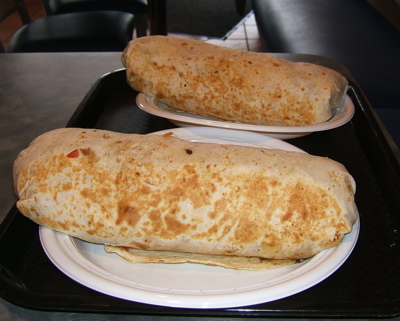Well, I haven’t put anything that I want to eat up here in a while so I thought today would be a good day to resume this.
Today is simple. All I want is….
A gigantic burrito.

I think the plan for today to actually fulfill this craving is to either make one of these bad boys at home, or stop at Qdoba for lunch.
I got to thinking later on, why is Qdoba so delicious? Why do I frequent Qdoba rather than Chipolte? I think I can sum it up in three words. Chicken Queso Burrito. The queso sauce at Qdoba is incredible. I can’t understand why they haven’t even attempted to create a queso sauce at Chipolte.
If you ever feel like making the stuff at home, here’s how. You can definitely decide not to roast the peppers and use canned tomatoes, but the stuff tastes a whole hell of a lot better if you do.
Qdoba’s Queso Dip:
Ingredients:
- 2 medium (about 6 ounces total) fresh poblano chiles
- 6 ounces (1 medium round or 2 plum) ripe tomatoes
- 2 garlic cloves, unpeeled
- 3 tablespoons chopped flatleaf parsley
- Salt to taste
- 2 tablespoons finely crumbled of each cheese, Monterrey Jack, American and cheddar cheese
Preheat the broiler. Place the poblanos, tomatoes and garlic on a baking sheet. Set the sheet 4 inches below a very hot broiler. Roast, turning every couple of minutes, until the chiles and tomatoes are soft, blistered and blackened in spots and the garlic is soft, 12 to 13 minutes total.
Place the chiles in a bowl, cover them with a towel, and let them stand 5 minutes, then wipe off the blackened skin. Pull or cut out the stems, seed pods and seeds; rinse quickly to remove any stray seeds and bits of char.
When the tomatoes are cool, peel off and discard their skins.
Slip the papery skins off the garlic.
In a food processor, make a puree of the roasted garlic and poblanos. Place the puree in a large bowl.
Chop the roasted tomatoes (for this recipe it’s best not to use any of the juice from the baking sheet) and add to the poblano mixture along with the parsley.
Coarsely mash everything together. Taste and season with salt, usually a scant teaspoon.
Cover the mixture with plastic wrap, placing it directly on the surface, and refrigerate until you’re ready to eat.
